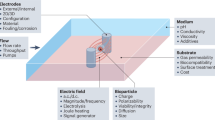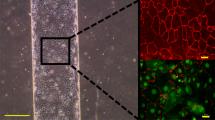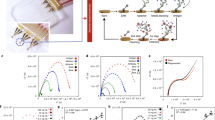Abstract
Microsystems create new opportunities for the spatial and temporal control of cell growth and stimuli by combining surfaces that mimic complex biochemistries and geometries of the extracellular matrix with microfluidic channels that regulate transport of fluids and soluble factors. Further integration with bioanalytic microsystems results in multifunctional platforms for basic biological insights into cells and tissues, as well as for cell-based sensors with biochemical, biomedical and environmental functions. Highly integrated microdevices show great promise for basic biomedical and pharmaceutical research, and robust and portable point-of-care devices could be used in clinical settings, in both the developed and the developing world.
This is a preview of subscription content, access via your institution
Access options
Subscription info for Japanese customers
We have a dedicated website for our Japanese customers. Please go to natureasia.com to subscribe to this journal.
Buy this article
- Purchase on SpringerLink
- Instant access to full article PDF
Prices may be subject to local taxes which are calculated during checkout




Similar content being viewed by others
References
Stone, H. A., Stroock, A. D. & Ajdari, A. Engineering flows in small devices: microfluidics toward a lab-on-a-chip. Annu. Rev. Fluid Mech. 36, 381–411 (2004).
Xia, Y. & Whitesides, G. M. Soft lithography. Annu. Rev. Mater. Sci. 28, 153–184 (1998).
van den Berg, A. & Lammerink, T. S. J. in Microsystem Technology in Chemistry and Life Science (eds Manz, A. & Becker, H.) 21–49 (Springer, Berlin, 1998).
Manz, A., Graber, N. & Widmer, H. M. Miniaturized total chemical-analysis systems — a novel concept for chemical sensing. Sens. Actuators B Chem. 1, 244–248 (1990).
Dittrich, P. S. & Manz, A. Lab-on-a-chip: microfluidics in drug discovery. Nature Rev. Drug Discov. 5, 210–218 (2006).
Bhatia, S. N., Balis, U. J., Yarmush, M. L. & Toner, M. Effect of cell–cell interactions in preservation of cellular phenotype: cocultivation of hepatocytes and nonparenchymal cells. FASEB J. 13, 1883–1900 (1999).
Folch, A. & Toner, M. Microengineering of cellular interactions. Annu. Rev. Biomed. Eng. 2, 227–256 (2000).
Tsang, V. L. & Bhatia, S. N. Three-dimensional tissue fabrication. Adv. Drug Deliv. Rev. 56, 1635–1647 (2004).
Britland, S., Clark, P., Connolly, P. & Moores, G. Micropatterned substratum adhesiveness — a model for morphogenetic cues controlling cell behavior. Exp. Cell Res. 198, 124–129 (1992).
Chen, C. S., Mrksich, M., Huang, S., Whitesides, G. M. & Ingber, D. E. Geometric control of cell life and death. Science 276, 1425–1428 (1997).
Théry, M. et al. The extracellular matrix guides the orientation of the cell division axis. Nature Cell Biol. 7, 947–953 (2005).
Tan, J. L. et al. Cells lying on a bed of microneedles: an approach to isolate mechanical force. Proc. Natl Acad. Sci. USA 100, 1484–1489 (2003).
Sivaraman, A. et al. A microscale in vitro physiological model of the liver: predictive screens for drug metabolism and enzyme induction. Curr. Drug Metab. 6, 569–591 (2005).
Powers, M. J. et al. A microfabricated array bioreactor for perfused 3D liver culture. Biotechnol. Bioeng. 78, 257–269 (2002).
Guguenguillouzo, C. et al. Maintenance and reversibility of active albumin secretion by adult-rat hepatocytes co-cultured with another liver epithelial-cell type. Exp. Cell Res. 143, 47–54 (1983).
Bhatia, S. N., Yarmush, M. L. & Toner, M. Controlling cell interactions by micropatterning in co-cultures: hepatocytes and 3T3 fibroblasts. J. Biomed. Mater. Res. 34, 189–199 (1997).
Liegibel, U. M. et al. Fluid shear of low magnitude increases growth and expression of TGF beta 1 and adhesion molecules in human bone cells in vitro. Exp. Clin. Endocrinol. Diabetes 112, 356–363 (2004).
Leclerc, E. et al. Study of osteoblastic cells in a microfluidic environment. Biomaterials 27, 586–595 (2006).
Groisman, A. et al. A microfluidic chemostat for experiments with bacterial and yeast cells. Nature Methods 2, 685–689 (2005).
Balagadde, F. K., You, L. C., Hansen, C. L., Arnold, F. H. & Quake, S. R. Long-term monitoring of bacteria undergoing programmed population control in a microchemostat. Science 309, 137–140 (2005).
Szita, N. et al. Development of a multiplexed microbioreactor system for high-throughput bioprocessing. Lab Chip 5, 819–826 (2005).
Boccazzi, P. et al. Gene expression analysis of Escherichia coli grown in miniaturized bioreactor platforms for high-throughput analysis of growth and genomic data. Appl. Microbiol. Biotechnol. 68, 518–532 (2005).
Vilkner, T., Janasek, D. & Manz, A. Micro total analysis systems. Recent developments. Anal. Chem. 76, 3373–3385 (2004).
Lion, N. et al. Microfluidic systems in proteomics. Electrophoresis 24, 3533–3562 (2003).
Auroux, P. A., Koc, Y., deMello, A., Manz, A. & Day, P. J. R. Miniaturised nucleic acid analysis. Lab Chip 4, 534–546 (2004).
Andersson, H. & van den Berg, A. Microfluidic devices for cellomics: a review. Sens. Actuators B Chem. 92, 315–325 (2003).
Verpoorte, E. Microfluidic chips for clinical and forensic analysis. Electrophoresis 23, 677–712 (2002).
Breslauer, D. N., Lee, P. J. & Lee, L. P. Microfluidics-based systems biology. Mol. Biosys. 2, 97–112 (2006).
Helmke, B. P. & Minerick, A. R. Designing a nano-interface in a microfluidic chip to probe living cells: challenges and perspectives. Proc. Natl Acad. Sci. USA 103, 6419–6424 (2006).
Jeon, N. L. et al. Neutrophil chemotaxis in linear and complex gradients of interleukin-8 formed in a microfabricated device. Nature Biotechnol. 20, 826–830 (2002).
Walker, G. M. et al. Effects of flow and diffusion on chemotaxis studies in a microfabricated gradient generator. Lab Chip 5, 611–618 (2005).
Abhyankar, V. V., Lokuta, M. A., Huttenlocher, A. & Beebe, D. J. Characterization of a membrane-based gradient generator for use in cell-signaling studies. Lab Chip 6, 389–393 (2006).
Hung, P. J., Lee, P. J., Sabounchi, P., Lin, R. & Lee, L. P. Continuous perfusion microfluidic cell culture array for high-throughput cell-based assays. Biotechnol. Bioeng. 89, 1–8 (2005).
Takayama, S. et al. Laminar flows — subcellular positioning of small molecules. Nature 411, 1016 (2001).
Lucchetta, E. M., Lee, J. H., Fu, L. A., Patel, N. H. & Ismagilov, R. F. Dynamics of Drosophila embryonic patterning network perturbed in space and time using microfluidics. Nature 434, 1134–1138 (2005).
Yang, M. S., Li, C. W. & Yang, J. Cell docking and on-chip monitoring of cellular reactions with a controlled concentration gradient on a microfluidic device. Anal. Chem. 74, 3991–4001 (2002).
Lee, P. J., Hung, P. J., Shaw, R., Jan, L. & Lee, L. P. Microfluidic application-specific integrated device for monitoring direct cell–cell communication via gap junctions between individual cell pairs. Appl. Phys. Lett. 86, 223902 (2005).
Wheeler, A. R. et al. Microfluidic device for single-cell analysis. Anal. Chem. 75, 3581–3586 (2003).
El-Ali, J., Gaudet, S., Gunther, A., Sorger, P. K. & Jensen, K. F. Cell stimulus and lysis in a microfluidic device with segmented gas-liquid flow. Anal. Chem. 77, 3629–3636 (2005).
Song, H., Tice, J. D. & Ismagilov, R. F. A microfluidic system for controlling reaction networks in time. Angew. Chem. Int. Edn Engl. 42, 768–772 (2003).
Brehm-Stecher, B. F. & Johnson, E. A. Single-cell microbiology: tools, technologies, and applications. Microbiol. Mol. Biol. Rev. 68, 538–559 (2004).
Gascoyne, P. R. C. & Vykoukal, J. V. Dielectrophoresis-based sample handling in general-purpose programmable diagnostic instruments. Proc. IEEE 92, 22–42 (2004).
Hu, X., Arnold, W. M. & Zimmermann, U. Alterations in the electrical properties of lymphocyte-T and lymphocyte-B membranes induced by mitogenic stimulation — activation monitored by electro-rotation of single cells. Biochim. Biophys. Acta 1021, 191–200 (1990).
Becker, F. F. et al. Separation of human breast-cancer cells from blood by differential dielectric affinity. Proc. Natl Acad. Sci. USA 92, 860–864 (1995).
Hu, X. Y. et al. Marker-specific sorting of rare cells using dielectrophoresis. Proc. Natl Acad. Sci. USA 102, 15757–15761 (2005).
Voldman, J., Gray, M. L., Toner, M. & Schmidt, M. A. A microfabrication-based dynamic array cytometer. Anal. Chem. 74, 3984–3990 (2002).
Huang, Y. et al. Dielectrophoretic cell separation and gene expression profiling on microelectronic chip arrays. Anal. Chem. 74, 3362–3371 (2002).
Fu, A. Y., Chou, H. P., Spence, C., Arnold, F. H. & Quake, S. R. An integrated microfabricated cell sorter. Anal. Chem. 74, 2451–2457 (2002).
Wang, M. M. et al. Microfluidic sorting of mammalian cells by optical force switching. Nature Biotechnol. 23, 83–87 (2005).
Chang, W. C., Lee, L. P. & Liepmann, D. Biomimetic technique for adhesion-based collection and separation of cells in a microfluidic channel. Lab Chip 5, 64–73 (2005).
Revzin, A., Sekine, K., Sin, A., Tompkins, R. G. & Toner, M. Development of a microfabricated cytometry platform for characterization and sorting of individual leukocytes. Lab Chip 5, 30–37 (2005).
Verpoorte, E. Chip vision — optics for microchips. Lab Chip 3, 42N–52N (2003).
Wang, Z. et al. Measurements of scattered light on a microchip flow cytometer with integrated polymer based optical elements. Lab Chip 4, 372–377 (2004).
Li, P. C. H. & Harrison, D. J. Transport, manipulation, and reaction of biological cells on-chip using electrokinetic effects. Anal. Chem. 69, 1564–1568 (1997).
Di Carlo, D., Jeong, K. H. & Lee, L. P. Reagentless mechanical cell lysis by nanoscale barbs in microchannels for sample preparation. Lab Chip 3, 287–291 (2003).
Lee, S. W. & Tai, Y. C. A micro cell lysis device. Sens. Actuators A Phys. 73, 74–79 (1999).
Lu, H., Schmidt, M. A. & Jensen, K. F. A microfluidic electroporation device for cell lysis. Lab Chip 5, 23–29 (2005).
McClain, M. A. et al. Microfluidic devices for the high-throughput chemical analysis of cells. Anal. Chem. 75, 5646–5655 (2003).
Lin, Y. C., Jen, C. M., Huang, M. Y., Wu, C. Y. & Lin, X. Z. Electroporation microchips for continuous gene transfection. Sens. Actuators B Chem. 79, 137–143 (2001).
Han, J. & Craighead, H. G. Separation of long DNA molecules in a microfabricated entropic trap array. Science 288, 1026–1029 (2000).
Fu, J. P., Mao, P. & Han, J. Y. Nanofilter array chip for fast gel-free biomolecule separation. Appl. Phys. Lett. 87, 263902 (2005).
Lu, H., Gaudet, S., Schmidt, M. A. & Jensen, K. F. A microfabricated device for subcellular organelle sorting. Anal. Chem. 76, 5705–5712 (2004).
Gottschlich, N., Jacobson, S. C., Culbertson, C. T. & Ramsey, J. M. Two-dimensional electrochromatography/capillary electrophoresis on a microchip. Anal. Chem. 73, 2669–2674 (2001).
Li, Y., Buch, J. S., Rosenberger, F., DeVoe, D. L. & Lee, C. S. Integration of isoelectric focusing with parallel sodium dodecyl sulfate gel electrophoresis for multidimensional protein separations in a plastic microfludic network. Anal. Chem. 76, 742–748 (2004).
Wang, Y. C., Stevens, A. L. & Han, J. Y. Million-fold preconcentration of proteins and peptides by nanofluidic filter. Anal. Chem. 77, 4293–4299 (2005).
Northrup, M. A., Ching, R. M. & Watson, R. T. in Proceedings of the 7th International Conference on Solid State Sensors and Actuators Yokahama, Japan 924–926 (IEEJ, Tokyo, 1993).
Burns, M. A. et al. An integrated nanoliter DNA analysis device. Science 282, 484–487 (1998).
Yin, N. F. et al. Microfluidic chip for peptide analysis with an integrated HPLC column, sample enrichment column, and nanoelectrospray tip. Anal. Chem. 77, 527–533 (2005).
Sato, K. et al. Microchip-based immunoassay system with branching multichannels for simultaneous determination of interferon-γ. Electrophoresis 23, 734–739 (2002).
Bernard, A., Michel, B. & Delamarche, E. Micromosaic immunoassays. Anal. Chem. 73, 8–12 (2001).
Wei, C. W., Cheng, J. Y., Huang, C. T., Yen, M. H. & Young, T. H. Using a microfluidic device for 1 µl DNA microarray hybridization in 500 s. Nucleic Acids Res. 33, e78 (2005).
Gruner, G. Carbon nanotube transistors for biosensing applications. Anal. Bioanal. Chem. 384, 322–335 (2006).
Zheng, G. F., Patolsky, F., Cui, Y., Wang, W. U. & Lieber, C. M. Multiplexed electrical detection of cancer markers with nanowire sensor arrays. Nature Biotechnol. 23, 1294–1301 (2005).
Burg, T. P. & Manalis, S. R. Suspended microchannel resonators for biomolecular detection. Appl. Phys. Lett. 83, 2698–2700 (2003).
Ziegler, C. Cantilever-based biosensors. Anal. Bioanal. Chem. 379, 946–959 (2004).
Clayton, J. Go with the microflow. Nature Methods 2, 621–627 (2005).
Gu, M. B., Mitchell, R. J. & Kim, B. C. Whole-cell-based biosensors for environmental biomonitoring and application. Adv. Biochem. Eng. Biotechnol. 87, 269–305 (2004).
Bousse, L. Whole cell biosensors. Sens. Actuators B Chem. 34, 270–275 (1996).
Pancrazio, J. J., Whelan, J. P., Borkholder, D. A., Ma, W. & Stenger, D. A. Development and application of cell-based biosensors. Ann. Biomed. Eng. 27, 697–711 (1999).
Gross, G. W., Harsch, A., Rhoades, B. K. & Gopel, W. Odor, drug and toxin analysis with neuronal networks in vitro: extracellular array recording of network responses. Biosens. Bioelectron. 12, 373–393 (1997).
Pearce, T. M., Wilson, J. A., Oakes, S. G., Chiu, S. Y. & Williams, J. C. Integrated microelectrode array and microfluidics for temperature clamp of sensory neurons in culture. Lab Chip 5, 97–101 (2005).
Chang, J. C., Brewer, G. J. & Wheeler, B. C. Modulation of neural network activity by patterning. Biosens. Bioelectron. 16, 527–533 (2001).
Morin, F. et al. Constraining the connectivity of neuronal networks cultured on microelectrode arrays with microfluidic techniques: a step towards neuron-based functional chips. Biosens. Bioelectron. 21, 1093–1100 (2006).
DeBusschere, B. D. & Kovacs, G. T. A. Portable cell-based biosensor system using integrated CMOS cell-cartridges. Biosens. Bioelectron. 16, 543–556 (2001).
Wood, C., Williams, C. & Waldron, G. J. Patch clamping by numbers. Drug Discov. Today 9, 434–441 (2004).
Fertig, N., Blick, R. H. & Behrends, J. C. Whole cell patch clamp recording performed on a planar glass chip. Biophys. J. 82, 3056–3062 (2002).
Schmidt, C., Mayer, M. & Vogel, H. A chip-based biosensor for the functional analysis of single ion channels. Angew. Chem. Int. Edn Engl. 39, 3137–3140 (2000).
Seo, J., Ionescu-Zanetti, C., Diamond, J., Lal, R. & Lee, L. P. Integrated multiple patch-clamp array chip via lateral cell trapping junctions. Appl. Phys. Lett. 84, 1973–1975 (2004).
Viravaidya, K., Sin, A. & Shuler, M. L. Development of a microscale cell culture analog to probe naphthalene toxicity. Biotechnol. Prog. 20, 316–323 (2004).
Abhyanakar, V. V. & Beebe, D. J. in Lab-on-Chips for Cellomics (eds Andersson, H. & van den Berg, A.) 257–272 (Kluwer Academic, Dordrecht, The Netherlands, 2004).
Chung, B. G. et al. Human neural stem cell growth and differentiation in a gradient-generating microfluidic device. Lab Chip 5, 401–406 (2005).
Kim, L., Vahey, M. D., Lee, H. Y. & Voldman, J. Microfluidic arrays for logarithmically perfused embryonic stem cell culture. Lab Chip 6, 394–406 (2006).
Pal, R. et al. An integrated microfluidic device for influenza and other genetic analyses. Lab Chip 5, 1024–1032 (2005).
Lagally, E. T. et al. Integrated portable genetic analysis microsystem for pathogen/infectious disease detection. Anal. Chem. 76, 3162–3170 (2004).
Blazej, R. G., Kumaresan, P. & Mathies, R. A. Microfabricated bioprocessor for integrated nanoliter-scale Sanger DNA sequencing. Proc. Natl Acad. Sci. USA 103, 7240–7245 (2006).
Hong, J. W., Studer, V., Hang, G., Anderson, W. F. & Quake, S. R. A nanoliter-scale nucleic acid processor with parallel architecture. Nature Biotechnol. 22, 435–439 (2004).
Wu, H. K., Wheeler, A. & Zare, R. N. Chemical cytometry on a picoliter-scale integrated microfluidic chip. Proc. Natl Acad. Sci. USA 101, 12809–12813 (2004).
Gao, J., Yin, X. F. & Fang, Z. L. Integration of single cell injection, cell lysis, separation and detection of intracellular constituents on a microfluidic chip. Lab Chip 4, 47–52 (2004).
Geiger, B., Bershadsky, A., Pankov, R. & Yamada, K. M. Transmembrane extracellular matrix–cytoskeleton crosstalk. Nature Rev. Mol. Cell Biol. 2, 793–805 (2001).
Jamora, C. & Fuchs, E. Intercellular adhesion, signalling and the cytoskeleton. Nature Cell Biol. 4, E101–E108 (2002).
Acknowledgements
The authors would like to acknowledge funding received from a National Institutes of Health grant.
Author information
Authors and Affiliations
Corresponding author
Ethics declarations
Competing interests
The authors declare no competing financial interests.
Additional information
Author Information Reprints and permissions information is available at npg.nature.com/reprintsandpermissions.
Rights and permissions
About this article
Cite this article
El-Ali, J., Sorger, P. & Jensen, K. Cells on chips. Nature 442, 403–411 (2006). https://doi.org/10.1038/nature05063
Published:
Issue Date:
DOI: https://doi.org/10.1038/nature05063
This article is cited by
-
Sorting Technology for Mesenchymal Stem Cells from a Single Tissue Source
Stem Cell Reviews and Reports (2024)
-
Microfluidic technology for cell biology–related applications: a review
Journal of Biological Physics (2024)
-
Use microfluidics to create microdroplets for culturing and investigating algal cells in a high-throughput manner
Microfluidics and Nanofluidics (2023)
-
Cell phone microscopy enabled low-cost manufacturable colorimetric urine glucose test
Biomedical Microdevices (2023)



